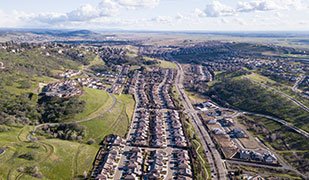The laid-back lifestyle of CA’s Central Coast is all about charming towns, like San Luis Obispo, Paso Robles, and Morro Bay, hundreds of wineries, thousands of hiking trails, great restaurants, and, of course, Big Sur.
These two hundred miles of scenic coastline, nestled between the Pacific Ocean and the mountains of the Coastal Range, offers visitors and residents alike everything from beautiful white beaches, great surfing, great opportunities to view wildlife whether you’re kayaking, biking, or hiking.
The weather of the Central Coast tends to be cooler and wetter in the winter, warm and dry in the summer – perfect for enjoying those lazy days of summer at any one of the many beaches of the Central California shoreline.
Over the past few years, California’s Central Coast has also become the “new hotspot” for Great White sharks as well as other types of sharks. According to Mike Harris, a sea otter biologist who works for the C.A. Department of Fish and Wildlife, shark sightings by Central Coast residents and visitors are becoming more and more common.
BLOG HIGHLIGHTS
-
Central Valley, CA population predictions

The Central Valley of California is experiencing a tremendous growth in its population. According to new data from the California’s Department of Finance, population predictions for the Central Valley indicate that the region’s population . . . READ MORE
-
Central Valley of CA tourism

When you think of places to visit in California, Los Angeles, Santa Barbara, and San Francisco are probably some of the destinations that come to mind. But have you considered vacationing in California’s Central Valley? You . . . READ MORE
So, what’s causing this spike in shark populations?
A change in tides
According to Chris Lowe, director of the shark lab at CSU at Long Beach, as the California coast has seen an increase in marine heat waves resulting from climate change, certain areas in the ocean now have warmer waters than in past years.
On the Fourth of July a park ranger specialist took a video of more than 50 leopard sharks swimming in circles in the shallow waters of Pirate’s Cove near Avila Beach in San Luis Obispo County while beachgoers remained mostly unaware of their presence.
The combination of rising water temperatures plus shark conservation efforts have made areas like the Central Coast of California a particularly appealing habitat for sharks, and not just smaller, harmless species.
Praise for the writing
The waters off the Central Coast have also become especially popular with juvenile great white sharks who frequent shallow waters as they are learning to hunt for food.
What this means for residents and visitors
What does the increase in shark sightings on the Central Coast mean for residents as well as visitors to the area beaches? Although swimmers, surfers, and kayakers are sharing the water with more sharks, according to Mike Harris, people should not expect an increase in the number of great white shark attacks on people.
Unfortunately, there have been reports of an increase in sea otter deaths due to shark bites by juvenile sharks that mistake them for seals or sea lions. And, in December, a boogie boarder was attacked and killed off Morro Bay.
The increased shark sightings along CA’s Central Coast are just another indicator of how climate change is changing the habitats of sharks and other marine life. And, it’s not just having an impact on coastal areas.
Jane's newest novel!

A once-thriving Central Valley farm town, is now filled with run-down Dollar Stores, llanterias, carnicerias, and shabby mini-marts that sell one-way bus tickets straight to Tijuana on the Flecha Amarilla line. It’s a place . . .
Unpredictable weather events, extreme temperatures, persistent drought, and devastating wildfires – how climate change is impacting the Central Valley of California, one of the most productive agricultural regions in the world. How are Central Valley farmers changing the way they farm to be part of the solution?
